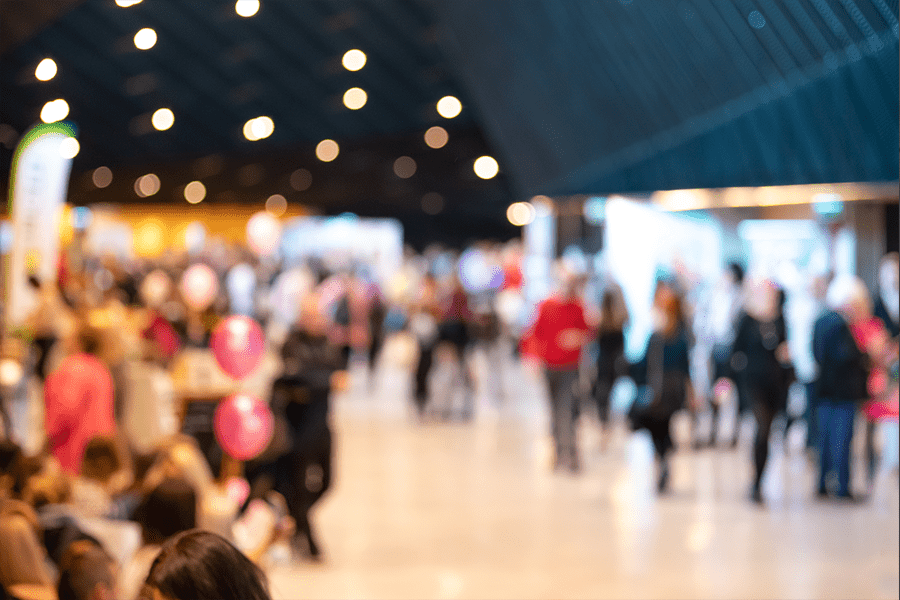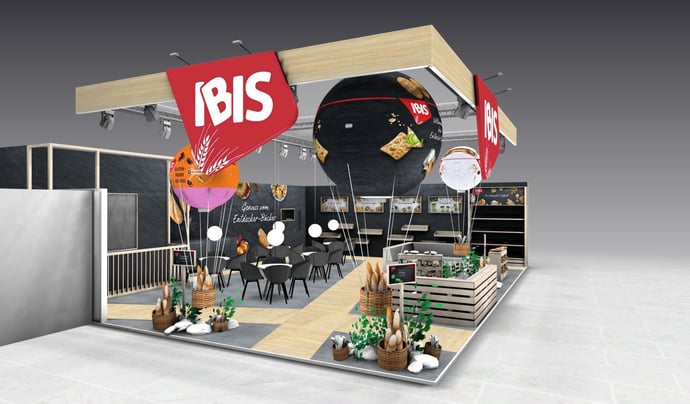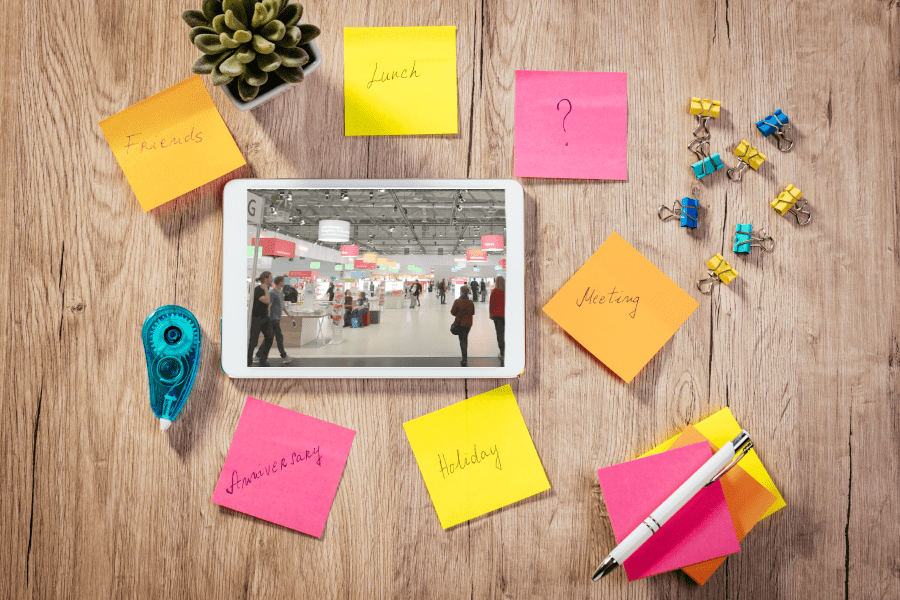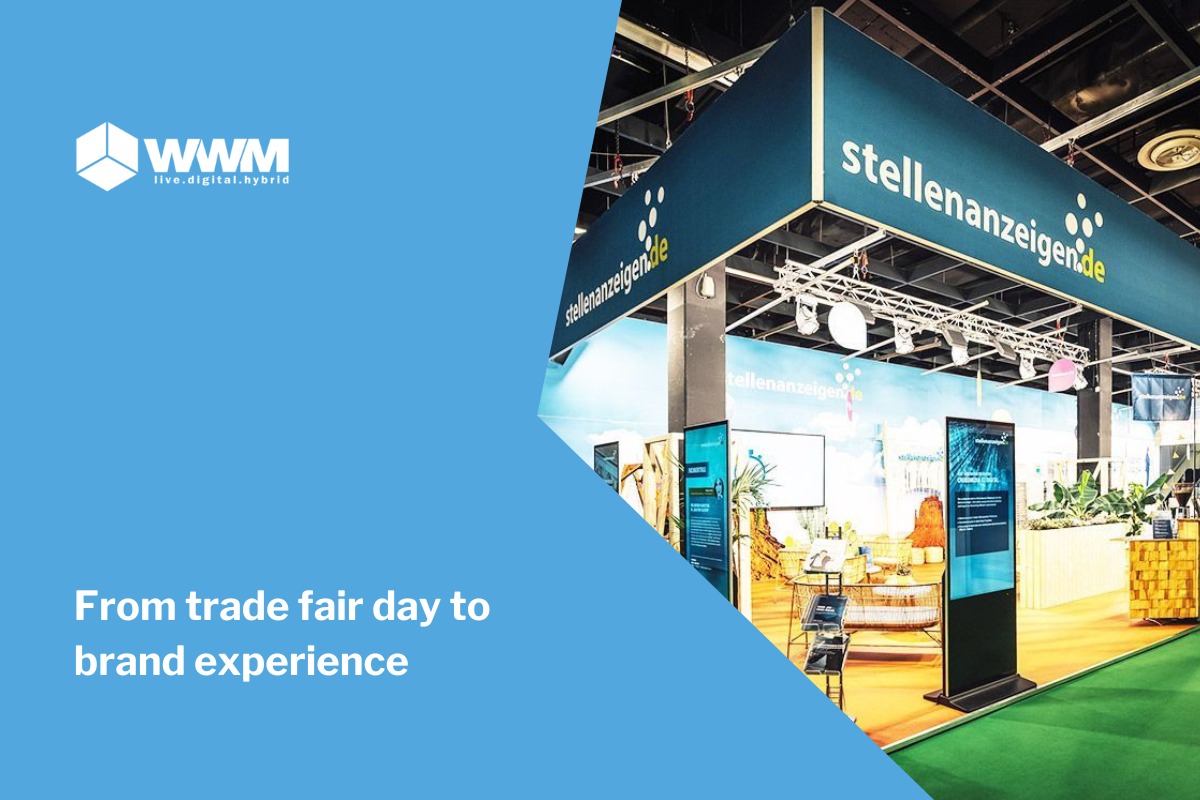Successful trade fairs after Corona
The coronavirus pandemic has really put a spanner in the works for exhibitors at trade fairs and congresses. Agile companies have reacted quickly and...

Measuring visitor flows is becoming increasingly important in the constantly advancing digitalisation of live communication. It is visualised in diagrams and key figures, giving us tangible indicators at all times. These key figures tell us how successful the trade fair is and what still needs to be optimised at the stand. This often results in new measurable goals, as we are no longer uncertain how our work is being received by others.
The success of a trade fair presentation is defined, among other things, by the number of visitors to the stand. With Event-Metrics, you can automatically record visitor flows and thus make trade fairs measurable. Visitors and their behaviour are recorded with the help of data protection-compliant WiFi tracking. The results are efficiently visualised in the form of diagrams and key figures. You can find more information in our whitepaper Visitor measurement with Event-Metrics Pro.
WiFi tracking uses the so-called ‘probe request’ of a smartphone to detect the presence of a person (or more precisely, a WiFi-enabled device) in a specific room. The probe request - also known colloquially as a Wi-Fi handshake - describes the search by a Wi-Fi-capable device for a Wi-Fi hotspot to which it could connect. As this probe request runs automatically in the background by the respective devices when Wi-Fi is activated, this signal can be used to detect the presence of the respective device.
The distance from the receiver (radius) is determined based on the comparison of theoretical and measured signal strength. Sounds simple - and it is.

The three phases of live communication are based on the operational workflow of efficient event management and have a continuous effect on the commitment and performance of event marketing. We accompany you through the individual phases, from planning and realisation to the subsequent analysis of your trade fair appearances.

Visitor measurement can help you to optimise your trade fair success even before the trade fair. Existing analyses and results from previous years can provide information that you should take into account when planning your trade fair stand. For example, it is possible to recognise in which areas of the exhibition hall most visitors are located. This makes it easier to determine the appropriate stand area and therefore the orientation of the stand. You can also look at how long visitors spend at a stand. Accordingly, you should create a suitable atmosphere that invites customers to linger. Catering should also be considered here.
Being successful essentially means nothing more than achieving your goals. In order to be able to check how successful a particular campaign was, the objectives must be clearly defined in advance. There are different objectives in event marketing. A basic distinction is made between operational and strategic objectives.
Another current topic is the counterpart to the physical trade fair stand: the virtual trade fair stand. This can also be a helpful tool when planning a trade fair appearance. On the one hand, you can prepare your team for the trade fair. All products are already clearly recognisable in the virtual stand and the most important information can be accessed via the info points. This ensures maximum efficiency when familiarising the stand personnel.
With the help of the virtual exhibition stand, you can measure in advance how well the stand is received by visitors. You can use customer feedback to optimise your trade fair concept if necessary in order to ensure the highest possible number of visitors to your ‘real’ trade fair stand.
This also brings us to the third point, ‘testing’. You can use your customers to measure at an early stage which products are well received on the stand and which are less interesting. You can also carry out A/B testing here.
Simply design two different exhibition stands and see which concept works better for your customers.

Another topic that is becoming increasingly present at trade fairs is the digital exhibition stand. With LED video walls on your exhibition stand, you can already benefit from your visitor measurement during the trade fair. With video walls, you are flexible in the display of digital content. For example, if you receive fewer visitors than expected, you can quickly change your content to achieve greater efficiency. The same also applies if you have high visitor numbers. By changing the content, your stand remains interesting and visitors return to your stand more often.
After the end of a trade fair, you can now clearly assess your success with the help of visitor flow measurement data. The analysis helps you to review the benefits and effectiveness of your trade fair presence. This allows you to strategically and rationally evaluate the measurable success of the trade fair and decide whether it is worth continuing to exhibit at this trade fair, which products were the most successful and which aspects you can still improve.

One aspect of visitor measurement is the analysis of visitor behaviour:
How many visitors were at my stand compared to the trade fair as a whole?
How many of the visitors returned to my stand?
What was the average length of time visitors spent at the stand?
This data can now be used to derive information for your next trade fair appearance. For example, you can consider optimising your stand:
Was your stand design not eye-catching enough?
Was your stand construction not inviting or did it lack incentives to linger?
Do you need to change something about the product presentation?
Next time, simply choose a different type of presentation or change the location of the products.
Secondly, you can compare the results of different trade fairs. See which trade fair attracts more visitors and where your products are best received. This allows you to decide which trade fair visit is more profitable for you and see where a repeat visit to the trade fair will pay off or not.
Here, too, you can benefit from the virtual exhibition stand. It can be used to extend trade fair times so that customers can view your stand again. First, you exhibit at the trade fair as usual in the ‘real’ stand.
The stands are then presented online on your website. People remember things better when they can see them in front of them. The virtual trade fair stand therefore helps customers to better remember products or related information. If a customer did not have much time at the trade fair or there was a large crowd at the stand, they can take a closer look at some things afterwards that they did not manage to see at the trade fair.
As a stand owner, this allows you to recognise how many customers come back to your stand. The number of visitors is measured here on the basis of clicks. On the one hand, this lets you know how attractive your stand is, and on the other, you can reactivate your visitors to stay in contact with you.
Measurability can be found in all areas of the trade fair world. In visitor measurement itself, but also in the areas of digital exhibition stands and virtual exhibition stands. Visitor measurement is becoming increasingly interesting and, above all, important. Knowing visitor behaviour and measuring visitor flows helps enormously when planning an optimal trade fair presence. Both before the trade fair with the correct positioning of the stand, during the trade fair itself by spontaneously adapting your content, and after the trade fair by analysing the data obtained, which is then used to plan the next trade fair appearance, thus completing the circle. Making trade fair success measurable should therefore be part of every trade fair planning process.

The coronavirus pandemic has really put a spanner in the works for exhibitors at trade fairs and congresses. Agile companies have reacted quickly and...

In recent years, trade fairs have evolved from mere platforms for product presentations to important touchpoints for brand-building experiences....

The last visitor has left the booth, the team has handed out the last giveaways, and the lights are slowly going out. The trade show is over. And...